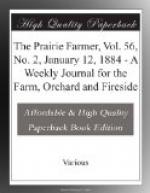Stiff, hard clays intended for tillage in the spring ought, by all means, to be broken up in the fall. A light, sandy soil should, on the contrary, be suffered to remain unbroken.
A wholesale drug house in Indianapolis, tells the editor of the Drainage Journal that tile drainage has reduced the sale of quinine and other fever and ague medicines nearly sixty per cent.
The American Cultivator says that if barley has not germinated the fact of its having been slightly stained by wet is no actual detriment whatsoever; the grain is not really injured and ought to bring to the farmer just as much as the bright samples of equal plumpness.
Dr. E. Lewis Sturtevant, reporting in Bulletin LXXII. of the State Experiment Station his hybridizing tests during the past season with 135 different kinds of corn, incidentally mentions that “the red ears have a constancy of color which is truly remarkable; where sweet corn appears upon red pop and red dent ears the sweet corn partakes of the red color.”
An esteemed exchange suggests, if farmers would go to the barn on a wet day and spend their time in making an eaves-trough for the barn or stable, and thereby carry away the drip which would otherwise fall on the manure pile, causing a waste of the elements of plant food contained therein, they will make more money that day than they could any fine day in the field.
American Cultivator: In winter, while the ground is covered with snow and the soil is frozen deeply, it is sometimes curious to note the effect of openings leading down to deep underdrains. The snow will be melted away by the warm air coming up from the unfrozen earth. Even in an uncovered drain three feet deep, a little straw or loose earth will generally protect the bottom from severe freezing.
Cincinnati Gazette: There are so many excellencies about the cow pea, and it is good for so many uses, that we advise our Ohio, Indiana, and Kentucky farmers to be sure and cultivate it this year. Next spring, when all danger of frost is over, sow, plant, or drill more or less of these valuable peas, and, in the language of the elder Weller, “you’ll be glad on it arterwards,” and so will your live stock.
New England Homestead: Nearly level culture, hand-hoeing and slightly hilling but once, and keeping the cultivator running, was recommended at the Waterbury meeting as the best culture for potatoes. It was said that the second hilling induced a second growth of roots higher up on the plant which produced small tubers. If this is not done the additional growth will make large potatoes.
Cincinnati Gazette: During sundry recent visits to Tennessee, we noticed that a considerable share of the immigrants arriving were from Michigan. They are mostly of the second generation from the settlers from the East in that State—men in the prime of life, who are seeking cheap lands in a genial climate, where the pastoral, dairy, and fruit-raising pursuits to which they are accustomed may be pursued with perfect success. Michigan farmers are usually intelligent, practical workers, who understand their profession and like it. They, and such as they, appreciate the advantages they will enter upon in their new homes at the South.




